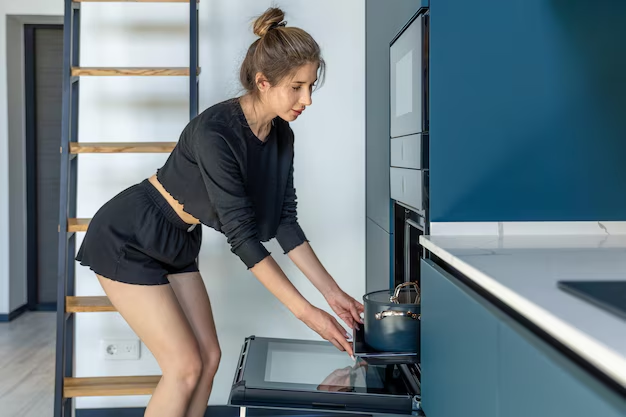How Cold Should a Salad Bar or Refrigerator Be? The Ultimate Guide to Optimal Temperature Management
From preserving freshness to ensuring safety, understanding the right temperatures for salad bars and refrigerators is crucial, especially when it comes to preventing foodborne illnesses. In this comprehensive guide, we explore the essentials for maintaining the ideal cold settings for your culinary investments, be it at home or in a commercial setup.
🥗 The Importance of Temperature Control in Salad Bars
Salad bars offer a delightful array of fresh vegetables, fruits, proteins, and dressings for a customizable meal experience. However, the freshness and safety of these ingredients rely heavily on proper temperature maintenance. Let's dig into why this is so important:
Temperature Thresholds for Safety
Maintaining the right temperature in salad bars is non-negotiable for preventing bacterial growth. The danger zone from 40°F to 140°F is where bacteria, like Salmonella and E. coli, thrive. For salad bars, keeping ingredients stored at temperatures below this threshold is critical.
Preserving Freshness and Quality
The freshness of salads is best preserved at cooler temperatures. Crispiness and nutritional value are better maintained when salad ingredients are stored at consistent cold temperatures. This enhances not only the visual appeal but the taste and texture as well.
Regulatory Compliance
In many places, health regulations dictate specific temperature requirements for food safety, especially for perishable items like those found in salad bars. Compliance helps avoid health code violations and ensures safe consumption.
🥶 The Ideal Temperature for Salad Bars
Ensuring that your salad bar maintains the appropriate temperature involves understanding and utilizing refrigeration equipment effectively.
Recommended Temperature Range
For optimal safety and quality, it's essential to keep salad bars at or below 40°F (4°C). This ensures reduced bacterial growth and keeps ingredients fresh. A consistent temperature minimizes the risk of spoilage and maintains product integrity.
Selection of Refrigeration Equipment
- 🧊 Refrigerated Display Cases: These are ideal for maintaining constant cool temperatures. They come with adjustable settings and built-in thermometers for real-time monitoring.
- 🌡️ Temperature-Controlled Tables: Ensure the display table itself has integrated cooling systems. They’re perfect for maintaining preset temperatures across various sections.
Regular Monitoring Practices
Frequent temperature checks using calibrated thermometers ensure that settings remain within safe limits. Automated alert systems can be integrated into modern systems to warn you of any temperature fluctuations.
🥶 How Cold Should a Refrigerator Be?
Refrigerators play a crucial role both at home and in professional environments to keep food fresh and safe. Let’s delve into the recommended settings and best practices.
Optimal Refrigerator Temperature
For comprehensive food safety, maintain the refrigerator temperature at below 40°F (4°C), with an optimal range between 32°F to 38°F (0°C to 3°C). This setting optimizes freshness without freezing the items.
Freezer Settings
Ideally, freezer compartments should be set to 0°F (-18°C) or lower to preserve the quality of frozen foods over time.
Best Practices for Home Refrigerators
- Keep It Stocked but Not Crowded: A well-stocked fridge retains cool temperatures better but avoid overcrowding, which can obstruct air circulation.
- Organize Accordingly: Group items based on their storage needs, such as storing raw meat at the bottom to prevent cross-contamination.
- Door Storage Caution: The refrigerator door is warmer; store condiments there, not perishable items like milk or eggs.
Smart Technology and Monitoring
Modern refrigerators are equipped with smart technology offering precise cooling adjustments, real-time monitoring, and alerts for temperature changes—perfect for the tech-savvy consumer.
🌡️ Transitioning Between Subtopics: Integrating Temperature Management Systems
Ensuring the right temperature settings for both salad bars and refrigerators extends beyond setting controls. It involves holistic management systems that integrate monitoring, maintenance, and hygiene practices.
Implement Temperature Logging Systems
For salad bars and refrigerators alike, implementing temperature logging systems can help track fluctuations. Digital logs offer insights into patterns that may suggest the need for maintenance or adjustments.
Regular Maintenance and Calibration
Routine maintenance ensures cooling systems operate efficiently. Regular calibration of thermostats and thermometers guarantees accurate readings for optimal operation.
Hygiene and Safety Protocols
Maintaining cleanliness in conjunction with temperature control bolsters food safety efforts. Regular cleaning schedules for both refrigerated displays and food storage areas prevent microbial growth and ensure longevity for your equipment.
📋 Key Takeaways for Temperature Management
Here's a summary of essential tips for quick reference:
- 💡 Stay Below 40°F: Maintain salad bar and refrigerator temperatures under 40°F for safety.
- 🧊 Ensure Distribution: Make sure cold air circulates freely for consistent cooling.
- 📉 Monitor Consistently: Use thermometers and alert systems to monitor conditions.
- 🔧 Perform Regular Maintenance: Keep equipment serviced to ensure optimum function.
- 🧹 Prioritize Hygiene: Regular cleaning complements temperature control for food safety.
Adopting these practices ensures you not only comply with safety regulations but also offer the best quality food experience whether at home or in a commercial environment. By giving your cooling systems and food safety protocols the attention they deserve, you secure not only freshness and quality but peace of mind.
